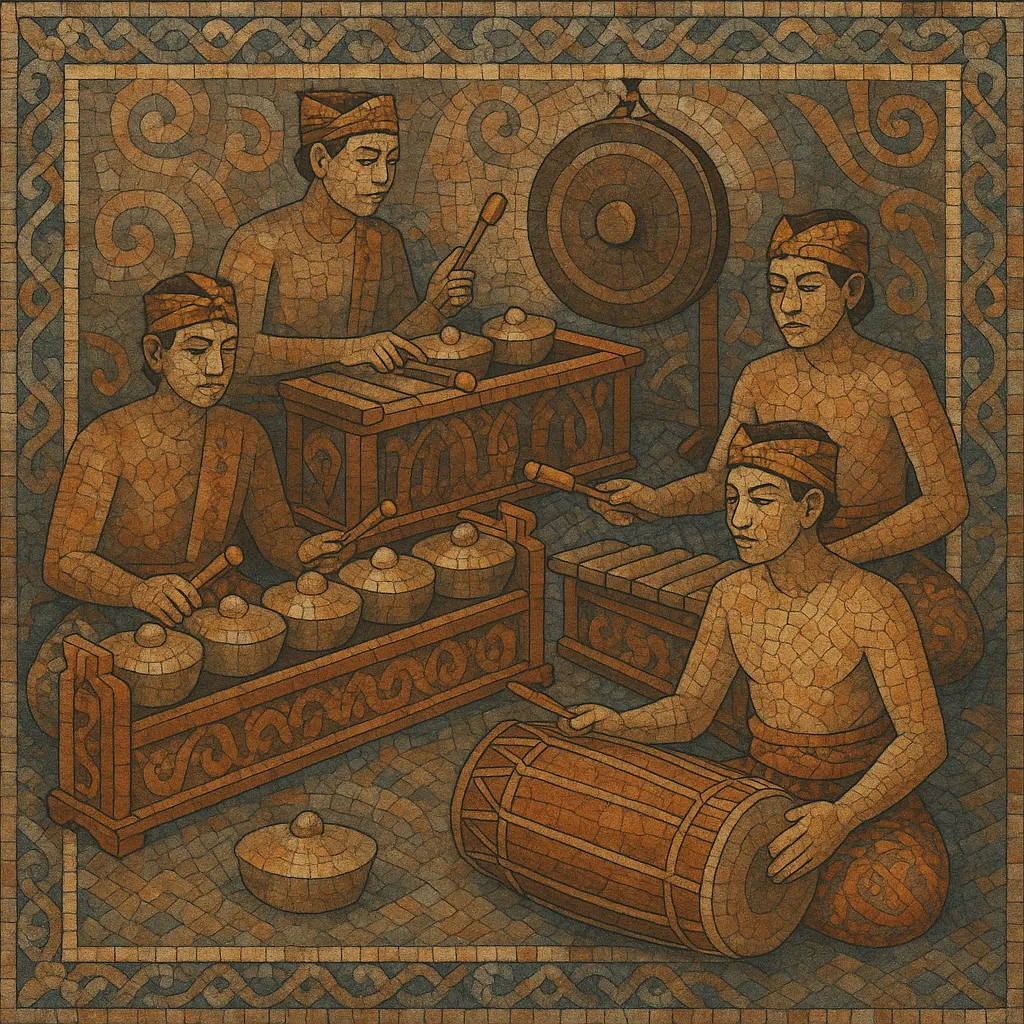Gamelan is a traditional Indonesian ensemble music, centered on tuned metal percussion (metallophones and gongs), drums, and soft-sounding melodic instruments. It is most closely associated with the islands of Java and Bali, where distinct courtly and village traditions evolved.
Its sound is defined by cyclical structures marked by gongs (colotomic cycles), interlocking figurations, and modal systems (laras) called sléndro and pélog. Textures are “stratified,” with a core melody (balungan) surrounded by elaborating parts. The result ranges from serene, floating atmospheres to dazzling, kinetic brilliance, depending on region and context.
Beyond ceremony and theater (wayang), gamelan has influenced global composers and experimentalists, while continuing to thrive in Indonesia as a living, communal art.
Reliefs from 8th–9th century Central Javanese temples (such as Borobudur and Prambanan) depict gong-chime ensembles, pointing to an ancient metallophone tradition. By the Majapahit period (13th–16th centuries), courtly music that we recognize as gamelan had taken clearer form, using bronze instruments and codified ceremonial functions.
In Central Java (Yogyakarta and Surakarta), gamelan flourished in kraton (palaces), where repertories, instrument names, and tuning practices were standardized. The Javanese system emphasizes pathet (modal/registral frameworks), colotomic cycles (ketawang, ladrang, lancaran, etc.), and stratified heterophony anchored by the balungan. Soft-style (alus) pieces feature rebab, suling, and vocals, while loud-style emphasizes bronze and drums.
In Bali, village-based ensembles evolved into highly virtuosic forms. The late 19th–early 20th centuries saw the rise of gamelan gong kebyar, famed for explosive dynamics, fast interlocking (kotekan), and abrupt contrasts. Earlier Balinese court ensembles—gong gede and semar pegulingan—provided foundations for later styles. Composers like I Wayan Lotring and I Wayan Beratha shaped modern repertoires.
Gamelan underscores rituals (e.g., sekaten festivities in Java), accompanies dance and wayang (shadow theater), and marks life-cycle events. Islamization in Java influenced repertories and ceremonial contexts, while older Hindu–Buddhist cosmologies remain embedded in symbolic instrument roles and cyclic conceptions of time.
From the early 20th century, Western composers and scholars (Colin McPhee, later Lou Harrison and others) studied and collaborated with Balinese and Javanese musicians, catalyzing “American gamelan” and impacting minimalism and world-fusion practices. Today, conservatories worldwide host gamelan ensembles, sustaining tradition and inspiring new composition.
Select a laras (sléndro or pélog) and a pathet (modal/registral framework) appropriate to time-of-day and affect. Decide on a colotomic form (e.g., ketawang 16-beat, ladrang 32-beat, lancaran 16-beat) and map where kempul, kenong, kethuk/kempyang, and the gong ageng articulate the cycle.
Compose a balungan (core melody) that fits the cycle length and pathet. Place kenong strokes at structural points (e.g., every 4 or 8 beats), kempul between them as needed, and the gong ageng at the cycle’s end. Use cadential tones that suit the pathet for strong repose.
Assign elaborating parts (panerusan): gender and gambang play cengkok (melodic patterns) around balungan tones; rebab and suling provide lyrical counter-lines; bonang leads by anticipating or guiding cadences. Keep the texture heterophonic—multiple lines orbiting the same skeleton at different densities.
Write kendhang patterns to cue tempo, transitions, and dynamic shape. For Balinese kebyar idioms, compose kotekan (interlocking polos/sangsih parts) that create rapid composite rhythms; use sudden dynamic changes and sectional contrasts.
Balance bronze timbres (saron, demung, peking, gender, bonang) with soft instruments (rebab, suling) and voice (gerong/sindhen). Consider sacred or ceremonial function when assigning instruments and pacing. Tune to a specific set (each gamelan is uniquely tuned) rather than equal temperament.
Use cipher notation (kepatihan) as a guide, but rely on oral transmission and idiomatic patterning. Rehearse ensemble entries, drumming cues, and colotomic markers so players internalize form and flow. Prioritize blend, cyclic breath, and communal timing over virtuosic display—except in kebyar, where contrast is integral.
If writing for wayang or dance, align musical sections to narrative scenes, cue changes with kendhang, and accommodate vocal texts and dalang timing.


